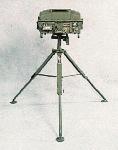 The M21 Automatic Chemical Agent Alarm provides the Army with the
first-ever capability of detecting chemical agent vapor clouds at a
distance. The Alarm was type classified standard and approved for full-rate
production in March 1995. Intellitec Corporation (formally Brunswick
Defense) will produce 156 M21 Alarms for fielding. The production option for
these units was awarded in May 1995, and the first Alarms will be fielded in
late 1996.
The M21 Automatic Chemical Agent Alarm provides the Army with the
first-ever capability of detecting chemical agent vapor clouds at a
distance. The Alarm was type classified standard and approved for full-rate
production in March 1995. Intellitec Corporation (formally Brunswick
Defense) will produce 156 M21 Alarms for fielding. The production option for
these units was awarded in May 1995, and the first Alarms will be fielded in
late 1996.
The M21 Alarm detects nerve and blister agent vapor clouds at line-of-sight distances out to 5 km. The M21 Alarm will be issued to Nuclear, Biological, and Chemical Reconnaissance teams for use either on its tripod or in conjunction with the NBC Reconnaissance Vehicle, known as the FOX, for surveillance or reconnaissance missions. The M21 Alarm needs to be stationary to make valid detection decisions. The improved FOX has an integrated mast assembly that stores the M21 Alarm and raises it during vehicle short halts to scan the area for agent clouds.
The M21 Alarm automatically scans a 60-degree arc, in seven field-of-view segments, to detect agent clouds. It is a passive infrared device that views the infrared energy much like your eye views visible light. The incoming energy is processed and compared against known agent spectra. When a detection (Nerve or Blister) is made, the alarm light illuminates and the horn sounds. Additionally, small field-of-view lights will illuminate to inform the operator in which of the seven fields of view an agent was detected. It is possible for several field-of-view lights to be illuminated at the same time and, subsequently, track a moving agent cloud.
The M21 Alarm was extensively tested in both technical and operational scenarios. It can detect chemical agent vapor clouds and track their movement through its fields of view. In controlled agent chamber tests, the M21 Alarm demonstrated a detection proficiency better than its requirements. Using the M21 Alarm's performance in the agent chamber and modeling to determine what agent concentrations are likely in different field situations, a series of user cards were developed to aid the soldier. These user cards predict the M21 Alarm's detection capability under a variety of field conditions.
The need for detecting a chemical agent cloud from a clean area has been evident for a long time. The current point detectors, and their operators, have to be in contact with the chemical agent in order to make a detection and generate a warning. Advance information of a chemical agent vapor hazard will allow the commander to chose an alternate route or take protective posture just before entering the contaminated area.
The research for remotely detecting chemical agent vapors was first initiated in the late 1950's using infrared technology. The M21 Alarm operates in the 8-12 micron region of the infrared spectrum. A Michaelson interferometer, the heart of the M21 Alarm, collects absorption or emission spectra from the chemical agent cloud and compares it to the background spectra. The early prototypes of the M21 Alarm were on a tripod; however, the computer that processed all of the collected spectra and generated the agent/no agent decision was housed in a Winnebago. The computer processing has been significantly improved and consolidated so that the detector assembly is now only 20 inches by 20 inches by 12 inches.
The development and testing of the Alarm hardware was a lengthy and challenging process. Much of the progress was made and technical hurdles overcome during the low-rate production phase using the team approach. As the low-rate production contract was awarded, the U.S. Army Chemical and Biological Defense Command began its momentous reorganization into self-directed work teams. The Alarm team members were matrixed from the Edgewood Research, Development, and Engineering Center to the Project Manager for NBC Defense Systems and reported directly to a System Manager or team leader, who was chartered by the Project Manager with overall management responsibility. Some of the team members served full time while others worked part time on the Alarm program and part time on other programs within the Organization.
The Alarm team (engineers, scientists, technicians, and logistics support personnel) was responsible for executing the low-rate production effort in accordance with the program baseline. The program baseline specified an aggressive schedule -- establish the production line, build low-rate production units, conduct production tests, and type classify in approximately 2 years. Without using a team approach, this task would never have been achieved. The benefits of a self-directed team were realized when the initial test efforts identified some hardware flaws. The team worked with the contractor, Brunswick Defense, to conduct failure analyses efforts, redesigns, and confirmation testing prior to restarting the formal test effort. The M21 Alarm Team is a group of individuals with a variety of backgrounds: quality, development, testing, logistics, and production. In the past, these team members were all assigned to separate organizations throughout the Edgewood RDEC and were required to work through their management structure to get work accomplished. The process has been reengineered so that one team is responsible for the development, testing, production, and fielding of the item.
The M21 Alarm has set the stage for the next generation of remote detection; the next generation remote detector will provide detection on-the-move and scanning in 360 degrees.


